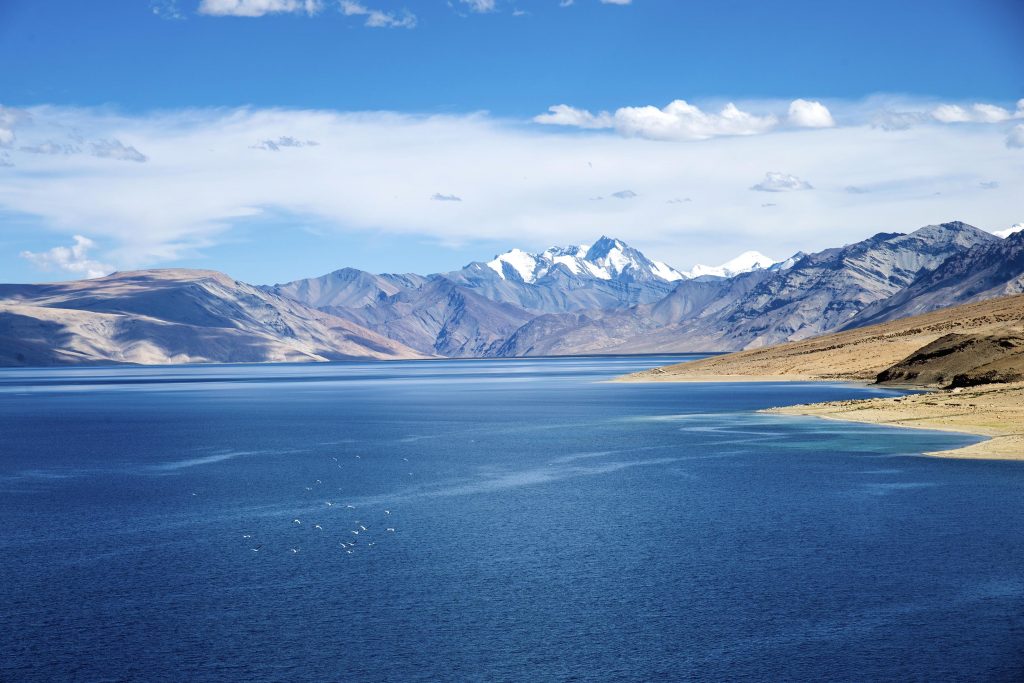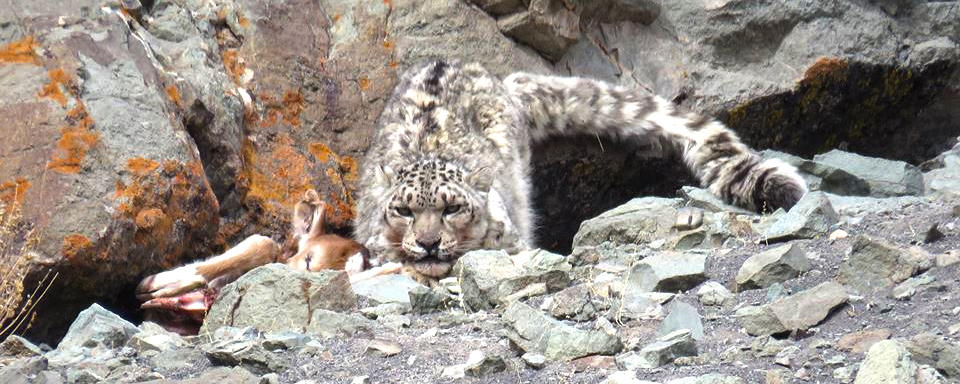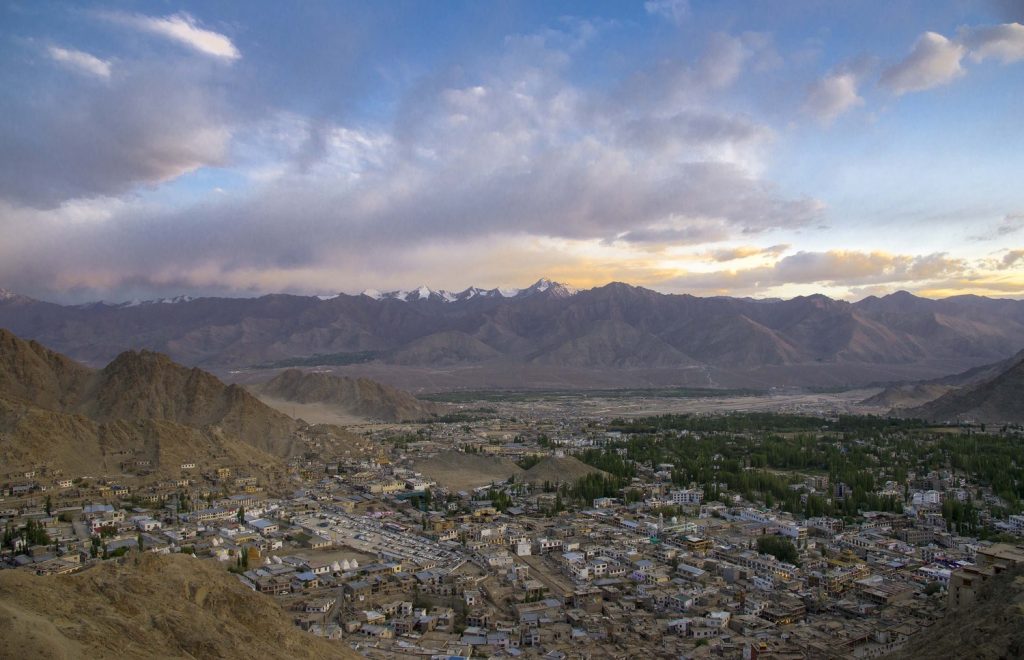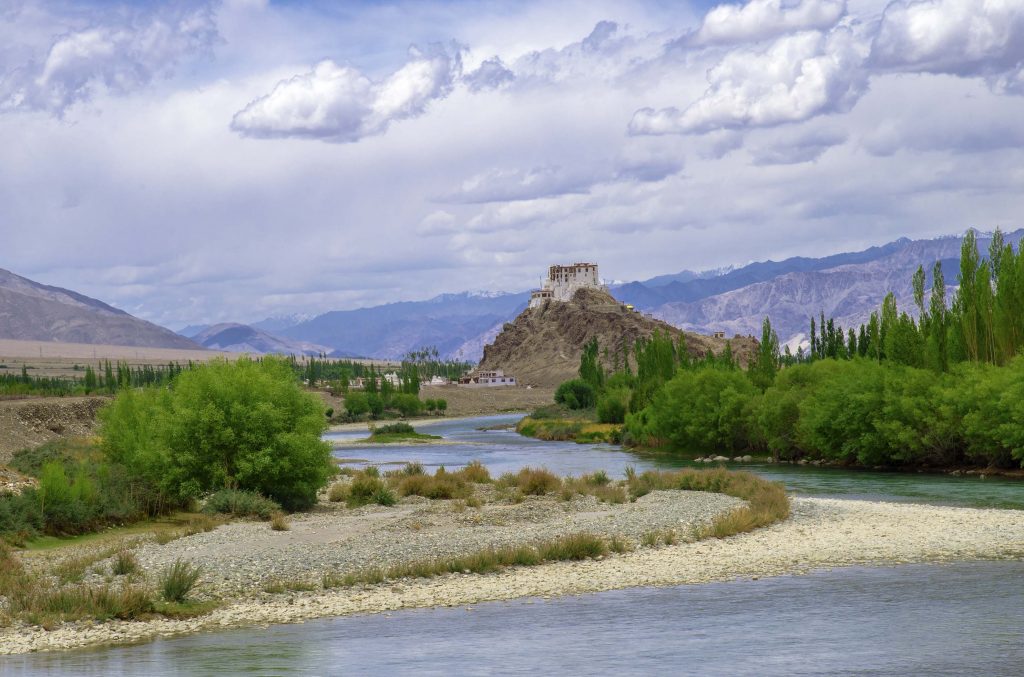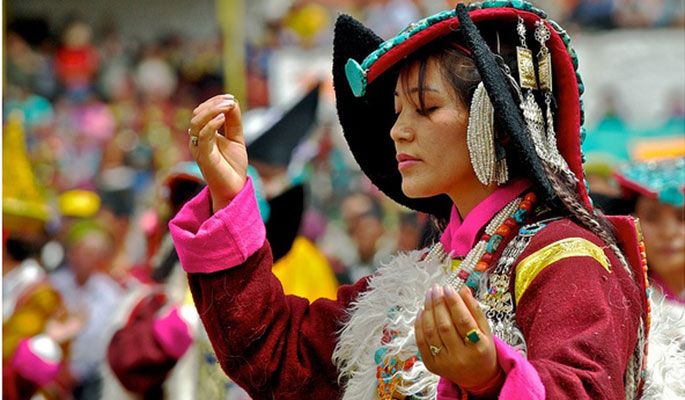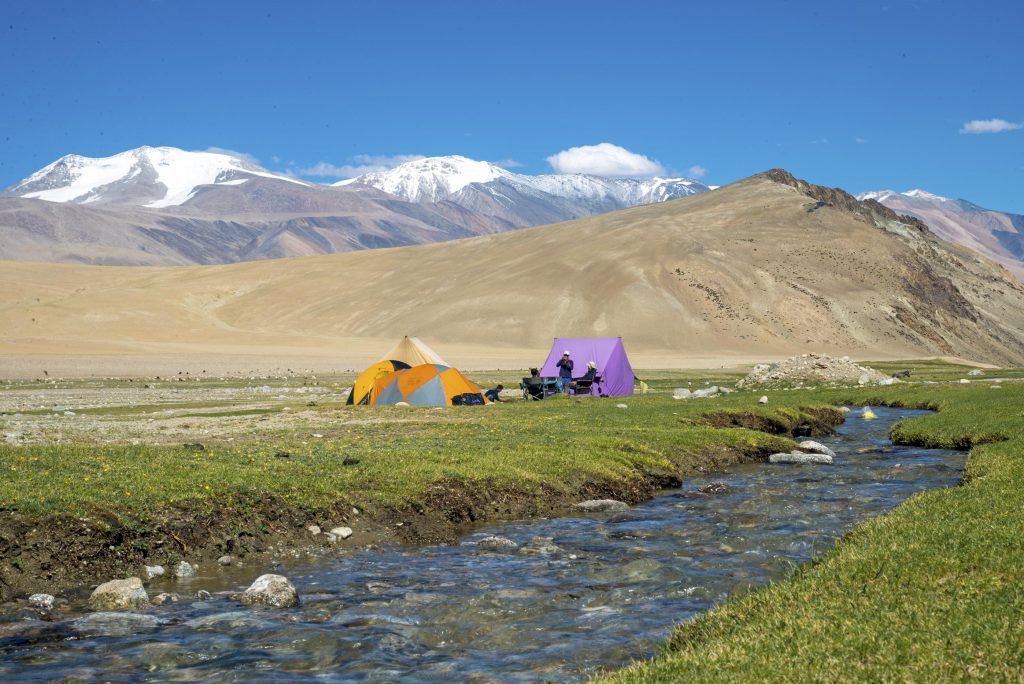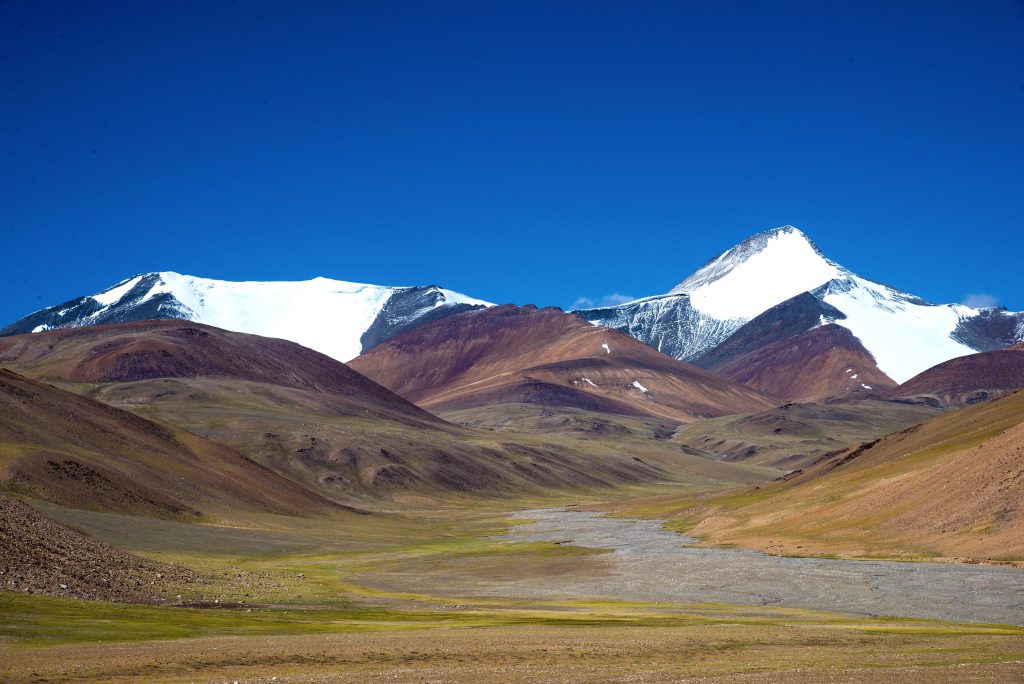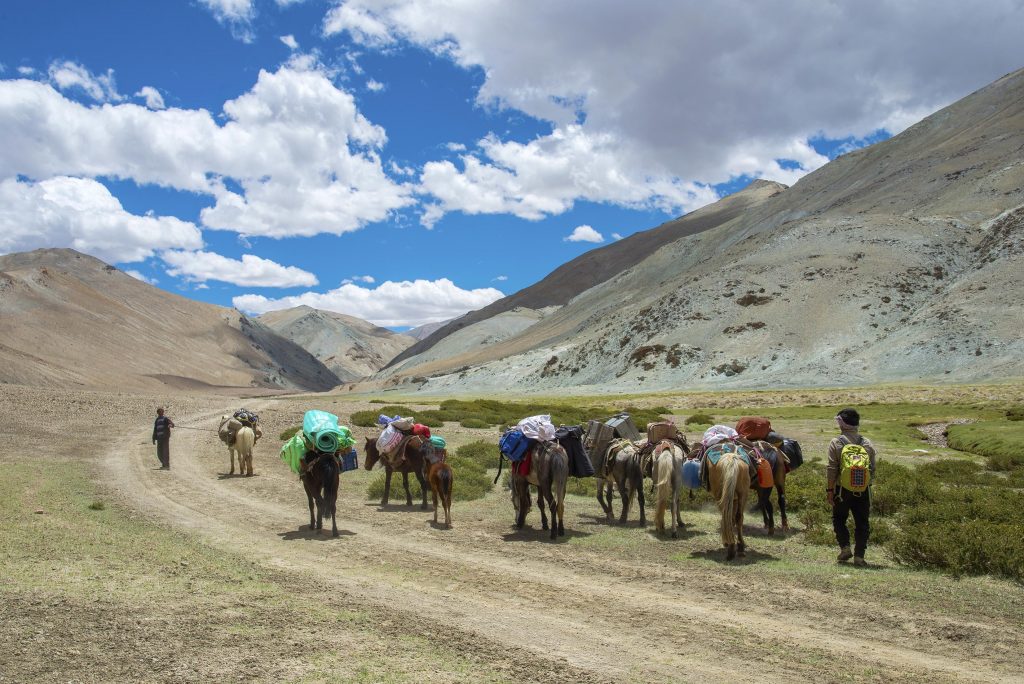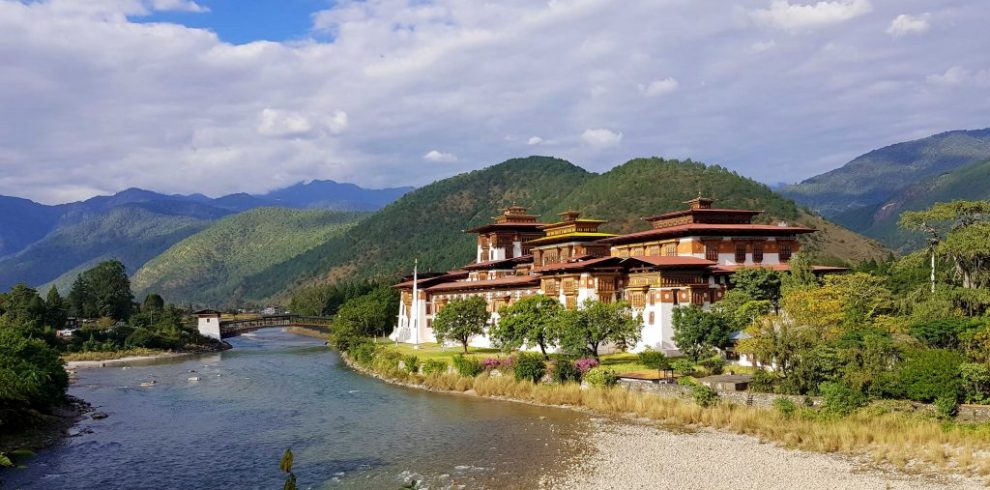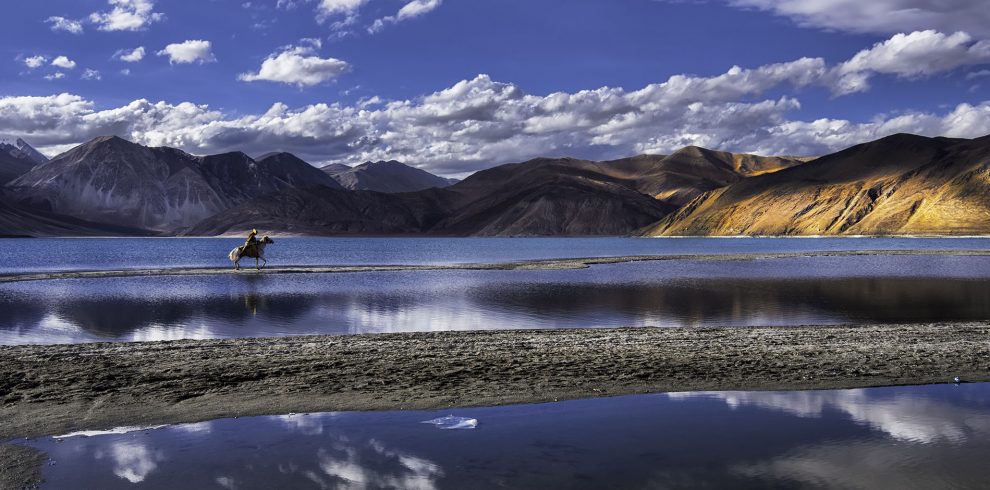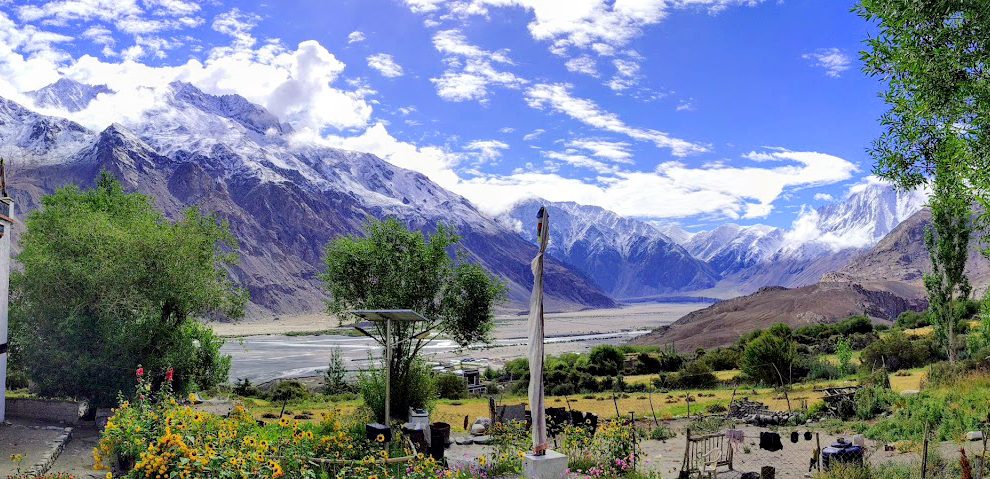Tsomoriri Lake which spreads over 120 Square kilometers, is the largest high-altitude lake in India that lies completely in India. This area is on the Changthang Plateau, which is famous for its outlandish landscape and Nomads and their traditional lifestyle. The area is also a famous for being a wildlife sanctuary, home to the endangered snow leopards and wild asses, as well as various species of birds, such as the black necked crane.
Overview
After arrival to New Delhi, we fly in to the Ladakhi capital of Leh, where we spend the next 4 days acclimatizing. During these 4 days we visit monasteries around Leh and also do a day trek from Likir to Yangthang for acclimatization. Having been acclimatized we drive from Leh to Rumtse on the Leh-Manali Highway. The trek from Rumtse passes through mesmerizing valleys completely uninhabited. It is a pure untouched nature, very rare to meet people but sure to have sightings of wild animals including, wolves, Lynx, Marmots and Argali (wild Tibetan sheep) and Kyang (wild Ass). After crossing two passes we reach Tsokar Lake. This is a salt water lake and was the main source of salt during the Trans Himalayan trade. After Tsokar we venture more deeper into the wilderness with outlandish landscapes, crossing high passes camping at extraordinarily beautiful campsites occasionally coming across Nomadic camps. We end the trek at Karzok, a small village which lies at the banks of Tsomoriri Lake. After the trek we drive back to Leh.
Highlights
- Spread over 120 square kilometres, Tso Moriri is the largest high-altitude lake that is entirely within India.
- Cross through seven mountain passes,
- Outlandish landscapes of Changthang Plateau.
- The Rocky Mountains that constantly change its colours as the day progresses.
- The home to Changpa nomads- It is an experience to see them camping with their livestock and to interact with them.
- Peaceful and serenely beautiful camping grounds of Kyamar, Tisaling and Rachungkharu.
- Home to some of the rare species of wildlife including Snow Leopard, Kyang (wild ass), Black Necked Cranes, Himalayan Ibex and several other species of brids and animals.
Itinerary
Altitude: 216m
On arrival to Indira Gandhi International Airport at New Delhi and finish with the immigration and custom formalities, our representative will meet you at the Main Exit with a Hi On Life Adventures placard. It is about 15 to 20 mins drive to the Aerocity where we have chosen your hotel for the practicality for the next days early morning domestic airport transfer. When you arrive at your hotel you will be briefed about your trek and "do's and don’ts" while your stay in India. In the evening we will have a welcome dinner to begin the taste of India at one of the finest dining in New Delhi.
Altitude: 3500m Flight duration: 1 hour 25 mins
Early morning drive to the domestic airport to fly to Leh. Be prepared for an extensive security checks for your own safety owing to the fact that Leh is strategically located close to Pakistan and China. Baggage allowance Delhi-Leh is only 15kg per person, unless you have a through ticket on the same airline internationally. However, excess baggage charges are only $5 per kilo. It will be an early morning flight to Leh which is a fantastic mountain flight. The flight takes about 1 hour and 20 mins to Leh and approach to the airport at Leh is extremely scenic, so get your cameras ready. The airport at Leh is also an Indian Air Force Base, therefore it is heavily guarded and again extensive security checks. We will be received at the airport by a representative from Ladakh and will be transferred to our hotel. An important component of our trip that we must adhere to is the acclimatization required due to high altitude. Do not plan on heading out at all today. Rehydration is the key to cope up with the high altitude, so drink water regularly. We will take this first day at high altitude with leisure, maximum exertion should maybe be a small stroll outside to the neighboring shops.
Altitude: 3500m- 3100m
Sightseeing duration with drives: 6 to 7 hours
We begin with a 40 km drive to Hemis. The wealthiest monastery of Ladakh and India, Hemis Monastery belongs to the Drukpa lineage of Tibetan Buddhism. The monastery was re-established in 1672 by the Ladakhi king Sengge Namgyal. After visiting Hemis monastery, we will visit Thiksey monastery. Thiksey monastery is affiliated with the Gelug sect of Tibetan Buddhism. It is located on top of a hill in Thiksey approximately 19 kms east of Leh. It is noted for its resemblance to the Potala Palace in Lhasa, Tibet and is the largest monastery in central Ladakh.
After the sightseeing, we will drive back to our hotel. The rest of the afternoon is free.
Altitude: 3100m- 3610m
Drive: 55 kms, 90 mins hours one way
Trek: 3 hours
We drive along the river Indus till Likir monastery, which is again an extremely scenic drive. From Likir we begin our trek on a jeep road until we reach a small pass called Phobe La (3580 mts). From here we leave the jeep road and walk an off the beaten track. After an hour walk we arrive at Sumdo village, cross the river and continue in the valley and finally reach the summit of Charatse La (3700 mts). From the summit descent to Yangthang Village. Yangthang is a beautiful agricultural village. After spending some time at the village, we drive back to Leh by late afternoon.
Today your guide will organize a short walk to Leh monastery for further acclimatization. You can utilize the rest of the day for last minute preparations before the trek.
Altitude: 3500m- 4100m
Sightseeing duration: 2 hrs drive + 3 hrs sight seeing
We drive from Leh to Rumtse and visit the monasteries of Shey, Thiksay and Hemis monasteries en route. Shey monastery: Along with the Palace was built in 1655 by King Deldan Namgyal. The monastery is noted for its giant copper with gilded gold statue of a seated Boudha. Palace was used as a summer retreat by the kings of Ladakh.Thikse monastery: It is noted for its resemblance to the Potala Palace in Lhasa, Tibet. Thikse monastery is a Tibetan Buddhist monastery of the Yellow Hat School (Gelugpa)
Hemis monastery: Built in 1672 by the Ladakhi king Sengge Namgyalis , is a Tibetan Buddhist monastery of the Drukpa Lineage,located in Hemis. The annual Hemis festival honoring Padmasambhava is held here in the month of June or July. By late afternoon, we reach the village of Rumtse. The local monastery near Rumtse, Gya, is 700 years old and has as many as 108 stupas. Overnight camping
Altitude: 4100 m to 4383m
Trek duration: 4 to 5 hours- of 9.5 km
After a short walk in the begining, the trail leaves Chhaba Chu and enter Kyamar valley. This point is a confluence of Kyamar stream and Chhabu Chu. There are many rivulets and can easily be crossed.Here the landscape is green marshy meadow which soon changes to gravel. There is a small gradual ascent over a rocky spur which leads to the base of this plateau. After walking for 30 minutes, the green marshes will re-appear along Kyamar stream. The Changpa nomads are known to camp here during summer. Kyamar’s grounds are surrounded by beautiful rocky hills on three sides of the valley. We will camp on a beautiful lush green grounds beside a stream. Overnight camping.
Altitude: 4383m – 5070m – 5200m – 4800m
Trek duration: 8-9 hours, 15 km
We have a long day ahead. We leave the green landscape behind as we now enter the barren mountains of the upper plateau of Kyamar. The trail now gradually climbs up as we approach the base of Kyamar La. Looking behind, we get splendid views of the Zanskar ranges. It is a gradual ascent and takes about an hour to reach the base of the pass. We cross a small stream from where it is a steep ascent all the way to the pass. From the top of the pass we get great breathtaking views of Changthang range with its colorful rife of mountain. After the pass we leave the Kyamar valley behind, and the trail starts to descend on the right side of the ridge for about 15 mins and then descend sharply. The trail is slippery, with loose gravel and takes 30-45 minutes to climb down to the river bed. We cross the Taasa Phu and again start to ascend towards Mandachalan La which takes about 2 ½ to 3 hours. Himalayan Ibex, Marmot and Wild hare are often seen here.The trail continues into a bowl-shaped valley and descends to the green camping ground of Tisaling below which is beautiful high altitude grassland.
Altitude: 4800m – 5290m – 4585m
Trek duration: 6-7 hours, 15 km
We begin with a gentle climb and then steepen gradual to the pass. It is about 2 hours to reach the top of Shibuk La. We are rewarded with spectacular views of the Tso Kar valley that stretches out right ahead of you. We can also get views of the salt lake, Tso Kar, in the distance. Mt. Thugse (6,050 m) and Mt. Gursan (6,370 m) stand prominently at the horizon. From the pass the trail follows a rocky scree and then continues along brackish barren land which has a unique array of colours that keep changing as the day progresses. It takes about 3 hours from the pass to the Tsokar basin. Soon we will be at our campsite at Pongunabu, which is a windy place. Overnight camping.
Altitude: 4585m to 4650m
Trek duration: 6-7 hours, 16 km
Today is a relatively easy day for trekking. The trail follows an easy but dusty jeep leading to Tso Kar lake. Along the salty shores of the lake, we can often see some of the endangered migratory birds like the black necked cranes and Brahminy ducks. The valley widens as we approach Nuruchen, a Changpa village. The trail has gentle ascents with level walks for most of the day but it is a long day. The campsite is on a grassy land beside a stream.
Altitude: 4650m – 4970m – 4925m
Trek duration: 4 hours, 9 km
Another fairly easy day. Horlam La is the easiest pass in this trek. From Nuruchen we proceed further towards south west into the Tso Moriri Valley. The ascent to the pass is gradual with marvelous views of the turquoise blue Tso Kar Lake behind. From the top of the pass, we descend to the grassy marshes of Spanglung Serpa river basin. The trail now takes you on a five kilometre stretch along the mushy masrshes of the rver basin till the campsite of Rachungkharu. Overnight camping
Altitude: 4925m – 5420m – 5400m – 5150m
Trek duration: 6 hours, 13 km
Today we have two of the most formidable pass crossings. The other challenge of the day is fording a series of rivulets, including a few of them that can be tricky. We follow the passing rivulet as we approach the base of the pass. After about an hour, we begin ascending all the way to the pass. It takes an hour to reach the top of Kyamayaru La. Ahead of us lies the wide valley of Gyam chu. After the pass, we descend to the extensive river basin of Gyam Chu. We cross the river and move ahead into Gyam Chu basin. The ascent to the next pass is steep. It takes close to two hours to reach the top which has several prayer flags neatly laid out. Descending from the pass we proceed towards the arid side of Gyamar basin. Here we have a few exhilarating experience of river-crossings. We will try boulder hopping or wade through the deep currents. After crossing the river, we warm up and dry ourselves as the water is icy cold. Gyamalhoma campsite is across the river, which is a beautiful pasture ground frequented by Changpa yak herders. Overnight camping
Altitude: 5150m – 5435m – 4540m
Trek distance: 6 hours, 14 km
Extremely scenic walk, prepare to cross the highest pass of the trek, the Yarlung La (5435m). We take the marked trail heading south east of the river valley and after an hour we will enter a rocky landscape. As we go higher, it gets windy with thunderous bursts. As we reach the top, the first appearance of Tso Moriri lake that dominates the landscape, is an overwhelming sight to fathom. We are rewarded with brilliant views of some snow caped peaks of Chhamsher Kangri (21,725 feet) and Lungser Kangri (21,870 feet). The descent to Tso Moriri lake is long and we descend about 3,000 feet. We continue to Karzok, which is located at the bank of Tso Moriri. There is an ancient 500-year-old Buddhist Monastery at Karzok. A beautiful campsite awaits us at the end of a long strenuous day. Overnight camping.
Drive: 7 hours
We drive back to Leh through the dramatic gorges of the mighty Indus, leaving behind the beautiful lake Tsomoriri. On arrival to Leh, we are transferred to our hotel. In the evening we might be able to organize a traditional Ladhaki cultural show depending on group size. Overnight hotel.
Flight duration: 1 hour 25 min
Sightseeing duration: 3 hours
Early morning drive to the airport to catch early morning flight to Delhi. Once again prepare for an extensive security checks. Lithium Batteries (eg spare camera batteries) – must be in your checked luggage for the return flight from Leh back to Delhi. On arrival to New Delhi we are transferred to our hotel. In the afternoon we take a Rikshaw ride through the narrow lanes of Old Delhi- a “must do” fascinating trip.
You will be transferred to Indira Gandhi International airport 4 hours before your flight departure time.
Drive: 5 hours
Sightseeing duration: 1 ½ hour
We begin early morning on a 233 km drive to Agra. The drive is comfortable and the road condition is of “Western standards” on the Express Highway. Before we go to our Hotel at Agra, we visit the Agra fort. Agra Fort is a massive and awe-inspiring fort built by the Emperor Shah Jahan during the Mughal reign in India. From here you can get the first glimpse of Taj Mahal across the river Yamuna. After visiting Agra fort, we check in to our hotel.
Drive: 5 hours
Sightseeing duration: 2 hours
An early morning visit to Taj Mahal to get the beautiful views of the first lights on this fabulous monument and also to avoid the crowd, which get very heavy during the day. Taj Mahal is one of the 8 wonders of the world and is one of the most beautiful monuments in the world. Neither any words, nor any pictures can justify the beauty of this amazing monument. We will spend a couple of hours at the Taj Mahal and then drive to our hotel. After breakfast, we drive back to New Delhi to our hotel. We arrive New Delhi early afternoon, so if you would wish to go to the main center for some shopping/ sightseeing, your guide can arrange or escort you.
Depending on your departure flight time, you guide can arrange additional trip around Delhi or you may just relax or enjoy the swimming pool at your hotel. We will drive you to Indira Gandhi International Airport 4 hours before your time of departure flight. Trip ends
Price Includes
- All International and Domestic airport transfers in Private A/C vehicle
- All guided sightseeing tours in Delhi, Ladakh and Agra in Private A/C vehicles
- 5 Star hotel accommodations on BB plan on twin sharing basis in New Delhi and Agra
- Welcome dinner in one of the finest authentic Indian dining in Delhi
- 3 Star category hotel in Leh on full board
- All Camping and Monasteries entrance fees
- Wild life fee for the applicable area
- Services of English speaking guide during trek only.
- Cook and kitchen helpers
- Horses and mules for carrying bags and camping gears
- Comfortable North face VE 25 tents on twin share basis unless single supplement is booked
- 1 ridge mattress + 1 Exped Down mattress for each person.
- Kitchen tent, Dining tent and Toilet tents
- Table Chairs and all Kitchen materials.
- All three times meals during trek. (Picnic at lunch time)
- Hot beverages with biscuits and snacks on arrival to camp
- Use of personal trekking pack consisting of a duffle bag, sleeping bag, sleeping bag liners, and down jacket.
- Hi On Life Adventures T shirt.
- Staff insurance and all applicable taxes
Price Excludes
- Insurance: Travel/Accident/Medical /emergency evacuation
- Private room accommodation in Delhi and Leh unless a single supplement is paid.
- Staff tipping
- Indian Visa
- Telephone, laundry, mineral water, soft drinks and alcoholic beverages.
- Emergency rescue evacuation cost if needed
- All other personal nature expenses.
About India
India, officially Republic of India, is the seventh largest country in the world by area. It also has the second largest population in the world with over a billion people, and prides in being the largest democracy on Earth. It is an extremely diverse country, with vast differences in geography, climate, culture, language and ethnicity across its expanse.
The earliest archaeological traces are from 7000 BC in Mehrgarh, which grew to be the “Indus Valley Civilization”, which is one of the earliest civilizations in the world. By 3300 BC, this civilization had well-planned towns and well-laid roads.
India’s culture and heritage are a rich combination of the past and the present. It offers the visitor a view of fascinating religions and ethnography, a vast variety of languages with more than 438 living languages, and monuments that have been present for thousands of years.
From the tallest mountain range in the world, Himalaya, to sun washed beaches, dense sub-tropical jungles to deserts, tranquil temples and rich architectural ancient monuments to frenetic bazaars, lantern lit villages to software supreme cities, India has it all. There’s simply no other word that captures the enigma that is in India. With an ability to aspire, frustrate, thrill and confound all at once, India presents an extraordinary spectrum of encounters for the traveler. India also boasts on having one of the wildest and largest culinary varieties in the world, each region presenting their own specialty. This is one country that will definitely jostle your entire being. It’s a place that fires the imagination and stirs the soul like nowhere else on earth.
India at a glance:
Area: 3,287,590 Sq Kms
Population: 1.2 billion
Capital city: New Delhi
About Ladakh
Ladakh, “The land of high passes”, is a region in the Indian state of Jammu and Kashmir. Although, rock carvings found in many parts of Ladakh indicate that the area has been inhabited from Neolithic times, not much is known about Ladakh before the 1st century. During the 2nd century when much of eastern Ladakh and western Tibet was still practicing the Bon religion, Buddhism started to spread into western Ladakh from Kashmir. In 842 Nyima-Gon, a Tibetan royal prince annexed Ladakh after the break-up of the Tibetan empire, and founded a separate Ladakhi dynasty. During this period, Ladakh acquired a predominantly Tibetan population. Also known as “Little Tibet” Ladakh’s culture and history are closely related to that of Tibet.
The largest town in Ladakh is Leh, followed by Kargil. Ladakhis are Tibetan-Mongoloid in appearance although traces of Kashmiri Moslem influence can also be seen. The predominant religion in Ladakh is the Tibetan form of Buddhism, although Islamic influences are found from the Kashmir Valley as far as Kargil, and there are some Christian families in Leh.
Some interesting facts about Ladakh
- Ladakh is the highest settlement in India. The fields at Korzok, on the Tso-moriri Lake, at 4,600m are widely considered to be the highest cultivated lands in the world.
- A Bailey bridge between the Suru River and Dras River in Ladakh, is the highest bridge in the world at an altitude of 5,602m.
- Only place in India where twin humped Bactrian camels can be found.
- Ladakh is home to the mystical Magnetic Hill, which is a so-called “gravity hill”. The alignment of the road with the slope of the background can give the illusion that cars are able to drift upwards.
- The Pangong lake in Ladakh is one of the highest salt lakes in the world
- Kadakh is also home to some of the rare species of wildlife including Snow Leopard, Kyang (wild ass), Black Necked Cranes, Himalayan Ibex and several other species of brids and animals.
Recommended preparation:
Stamina is essential, as walking days are long. We recommend previous trekking experience, preferably at altitude. Walking or jogging 45 mins to 1 hour for at least two times a week on undulating terrain or on a tread mill with inclined angle for at least 3 months prior to departure. Cycling is recommended. Long day hikes on weekends with a daypack in variable weather conditions is also recommended.
A Day On Your Trek
Although each day is different, considering the weather, general pace of the group and length of the days walk, in general your day begins with a wake up tea at around 6 to 6:30 in the morning. You will then be provided with a bowl of warm water for washing. Then you will need to pack your duffel bag and your daypack and come to the dining tent for breakfast.After breakfast we will hit the trail and usually walk for about 3 to 4 hrs before we stop for lunch. Lunches are usually picnic packed lunch. We allow you about an hour rest during lunch, which will also give enough time for the staff to prepare lunch, wash dishes and have their lunch and pack. Usually after 3 to 4 hrs of walking we finish the days walk by 4 PM. Tea/ Coffee and snacks will be served on arrival to the camp. Your Group Leader will often organize side trips in the afternoon.
Your dinner will be served around 7 PM.
Food and water
The cook and the kitchen crew prepares hot food which is normally a very balanced diet comprising of fresh vegetables and breads, to pastas and sandwiches and occasionally even cakes and pizzas. Breakfasts are usually bread eggs and cereals, and lunch and dinner are a three course meals. We make sure that you get the required amount of carbohydrates and proteins and vitamins as you burn a lot of calories walking uphills, so plenty of vegetables, canned meat and fish and eggs and cereals are carried.We provide boiled and treated water 4 times a day.
High Altitude
On this trek you will be going up to 5400m, so it is very important to understand the affects of altitude. The greatest provocation is going too high too fast. Hi On Life Adventures’s itinerary has been carefully designed to minimize the effects of altitude. We ascend slowly and surely allowing enough time for safe acclimatization.Headaches and breathlessness are common at altitude which in itself is nothing to worry about. In rare cases, this may worsen to Acute Mountain Sickness (AMS), so a close watch is kept on all trekkers by the group leader who is trained to recognize the symptoms of AMS which are severe headaches, nausea, lethargy, loss of appetite serious breathlessness even at rest. If any trekkers show such signs they will be descended to relatively lower and safer altitude. The Group Leader’s decision on evacuating such person to a safe altitude is final. Do not medicate yourself without first informing your group leader. Going to altitude slowly with adequate rest and adequate intake of fluid (3 to 4 litres per day), you will most likely have no problems apart from breathlessness on hills which is completely normal as the percentage of Oxygen in the air is relatively lower to that at sea level. The most important thing is not to worry about altitude because our team is there to take care of you.
Staff
Group leader: your most important member of your staff. Our Group leaders are highly trained in all aspects of the trek, conservation, first aid specializing on
altitude sickness, emergency procedures and have extensive knowledge of the natural history of the area.
Sirdar: His job is to manage and organize staff duties, select and organize campsites. He is responsible for the actual operation of the trek.
Sherpas: Their job is to lead your way and distribute equal loads to the porters and also help clients and other staff when need arises.
Porters: They are responsible to transport your duffle bags and their job finishes once they reach the designated lodge. Our porters are provided with Gore-Tex suits, trekking boots, gloves, hats, socks, snow gaiters and snow goggles. Most importantly, we regulate them on a 25 Kg carrying load. Our clients can therefore feel comfortable knowing that our porters are working in a good humane condition.
Please note: In our Ladakh trips, we do not use porters, instead we have mules and horses to carry the gears.
Weather
The best time for this trek is June till August. It is summer time in Ladakh and the temperatures are pleasant at high altitude. However, below 4000m it can be soaring 28 C in the sun. Another typical thing about the climate in Ladakh is that the temperature varies enormously. It can be 28 C+ on a sunny day and within an hour the temperature could drop below 10 C if it gets cloudy. At altitudes above 4500m the night time temperatures could drop just below freezing.
Recommendations for things you should bring:
- Water bottle: 3 bottles min 1 liter each, should be able to hold hot water)
- Day pack: medium size 35-40 liters
- Sunglasses: Poloroid/ UV protection 2-4
- Duct tape: Small roll for emergency fixing of torn jacket/ sleeping bags etc.
- Stuff bags: Small stuff bags or plastic bags to organize you duffle bag
- Money belt
- Toiletries: Your essentials. We provide toilet papers
- Towel: Quick dry travel towel
- Torch: Preferably head lamp
- Penknife
- Disposable lighter
- Sewing kit
- Medical kit: As per your prescriptions. It should be noted that the group leader will be carrying a first aid kit.
Optional
- Walking sticks ( highly recommended)
- Cameras
- Knee guard for those with bad knees.
- Daytime snack (chocolates/ dry fruit trail mix)
Clothing
- Trousers: 2 lightweight for easy walking and 1 warmer for colder days preferable wind/water proof, 1
- stretchable running trousers
- Shorts: 1 (Not too high cut revealing ones)
- T-shirts: 2 light cotton or preferably polypropylene
- Full sleeves T- shirts: 2 preferably poly propylene or wool.
- Hats: 1 Sunhat and 1 woollen one for colder days
- Buff (cover for your mouth and keeps your neck warm)
- Gloves: 1 warm woollen/ fleece and 1 medium weight Gore-Tex
- Thermal underwear: 2 pair light weight tops and trousers, preferably woollen, and 1 pair medium weight
- Socks: At least 4 pairs (both thin and thick woollen ones)
- Jackets: 1 fleece/ wool and 1 Gore-Tex wind/waterproof. Please note that we provide down jackets.
- Walking boots: Preferably waterproof
- Gym shoes/sandals For evenings
For every trek we provide these extremely warm down jacktes and -10C to -20C extreme temperature down sleeping bags depending on altitude.
Healthy and trouble free holiday
Please consult a doctor for vaccination against Typhoid, Meningitis, polio, and hepatitis. If you have special dietary requirements or allergies, please give us a list of what you can and can’t eat so that we can provide proper food for you. If you are undergoing a course of prescription medicine, please ensure that you have sufficient supplies for the entire holiday. Some types of drugs including antimalarias have side effects at high altitude; therefore please consult your doctors regarding these drugs. The places you trek are mosquito free and there has been no report on malaria in Ladakh and you do not spend a lot of time in the low
lands of India.
Insure yourself:
We highly recommend you to take a comprehensive Personal Travel Insurance before leaving home. This should cover for your loss of baggage, airline delays, sickness, and accidents. It should cover all incuring costs for evacuations.
Money Matters
The ideal currency to bring with you is USD or Euro. You can exchange them in Delhi or Leh. You can also draw money from ATM machines in New Delhi or Leh.The exchange rate is 1 USD = 62 Indian Rupees approx. (subject to change)
In Delhi and Agra: During the entire trip the only meals that you need to pay for are 3 dinners and 2 to 3 lunches depending on your time of departure flight. Delhi has a wide variety of restaurants with a very wide range of price. Depending on where you eat, each meal will cost anything between 5 to 25 USD + drinks. Plus 20 to 30 USD for your taxis if you wish to go around the city.
On trek: Basically there are no place where you can spend money on the trek. However, in few places you might find small tea shops that sells cold drinks, chocolates etc. It is recomended to bring around 5 USD per day. This money is chocolates, soft drinks and beers etc and also for small donations in the monasteries.
Tipping
Although tipping is entirely optional and personal matter the following is recommended as a guideline
In Delhi and Leh: for bellboys, waiters and porters 50 to 100 Indian Rupees
On the trek: At the end of the trek it is a customary to tip the field staff. The recommended amount is 100-150 USD depending on group size. The Group leader will collect the tip and then split it between the staff and put it in envelops so that the trekkers can give it to the staff during the “Farwell Ceremonies”. Please note- the Group Leader is not included in this tip. If you want to tip the Group Leader, you can do it seperately.
Some Do’s and Don’ts
Ladakhki people treat visitors as special guests. Although they will never rebuke you publicly for unknowingly offending them, we must consider their culture.
While in Ladakh please observe the following:
- Full or partial nudity is not accepted.
- Over display of affection between men and women, especially in temples and monasteries are discouraged.
- Please remove your shoes before entering monasteries and temples.
- Never point the soles of your feet at a person or shrine.
- Locals walk around the Mani walls and Stupas in a clockwise direction as a respect and they expect you to do the same although it is not compulsory.
- Please ask before taking pics of a person or his/her child
Some useful tips while travelling in Delhi and Agra
Dress code: Dress sensibly and don’t walk around alone at night. For men knee length shorts and t shirts and sandals are best to cope up with the heat but in some temple and mosques you need to wear long trousers. For women it would be wise to cover up and dress modestly to avoid unwarranted advances. Light cotton trousers or knee length skirts are ideal and avoid bare back dresses.
Personal space: The concept of personal space is almost nonexistent in almost all over India. Whether you’re standing in a queue or walking in a crowded Bazaar, get used to moving shoulder-to-shoulder.
People in North India tend to stare a lot: Please don’t be offended because most of them do this out of curiosity. Easy way to deal with this is to not make direct eye contact with strangers and passersby. Get used to it and don’t let this make you uncomfortable.
Bargaining skills: In shopping malls the prices are fixed and you cannot bargain. However, in rest of your shopping adventure, it is inevitable that you will be exploited to a certain degree, the simple fact is that most vendors know you have money. Skillful bartering takes practice- a beginner’s rule of thumb is to cut the
starting price in half and then work your way to a middle ground.
Beware of Pickpockets: The streets of Delhi can become very crowded, exposing you up to a risk of being easily pick-pocketed. Keep your money in your money belt or in a forward facing backpack to avoid any thieves. If you need to take money out of your wallet, it is best to find a quiet spot and do it quickly to avoid being robbed.
Beggars: You will likely see things that strike your emotional core, but it is important to realize that these are deep rooted problems with no easy fix. Moreover if you give money to one beggar, within secs you will find yourself surrounded by a dozen other beggars from children to adults. Also keep in mind that beggar mafias control much of the inner city.
Street Hawkers: When you walk out of the sightseeing points you will meet several hawkers trying to sell you small souvenirs from pics and all sorts of things. Do not engage in a bargain or converstation unless you really want to buy them. They can be very pushy sometimes.
Go With the Flow: Despite the fact that the cities in India can be tiring with all the staring, crowded streets, beggars, pestering hawkers’ etc. try not to care about the small stuff. If you get caught up and stress about the little things, you will miss out on the bigger picture, which is that you are in one of the most distinctive and important cities in the world. The city will often come to feel like another planet entirely.
“TODAY IS YOUR DAY! YOUR MOUNTAIN IS WAITING, SO… GET ON YOUR WAY!”
DR. SEUSS


